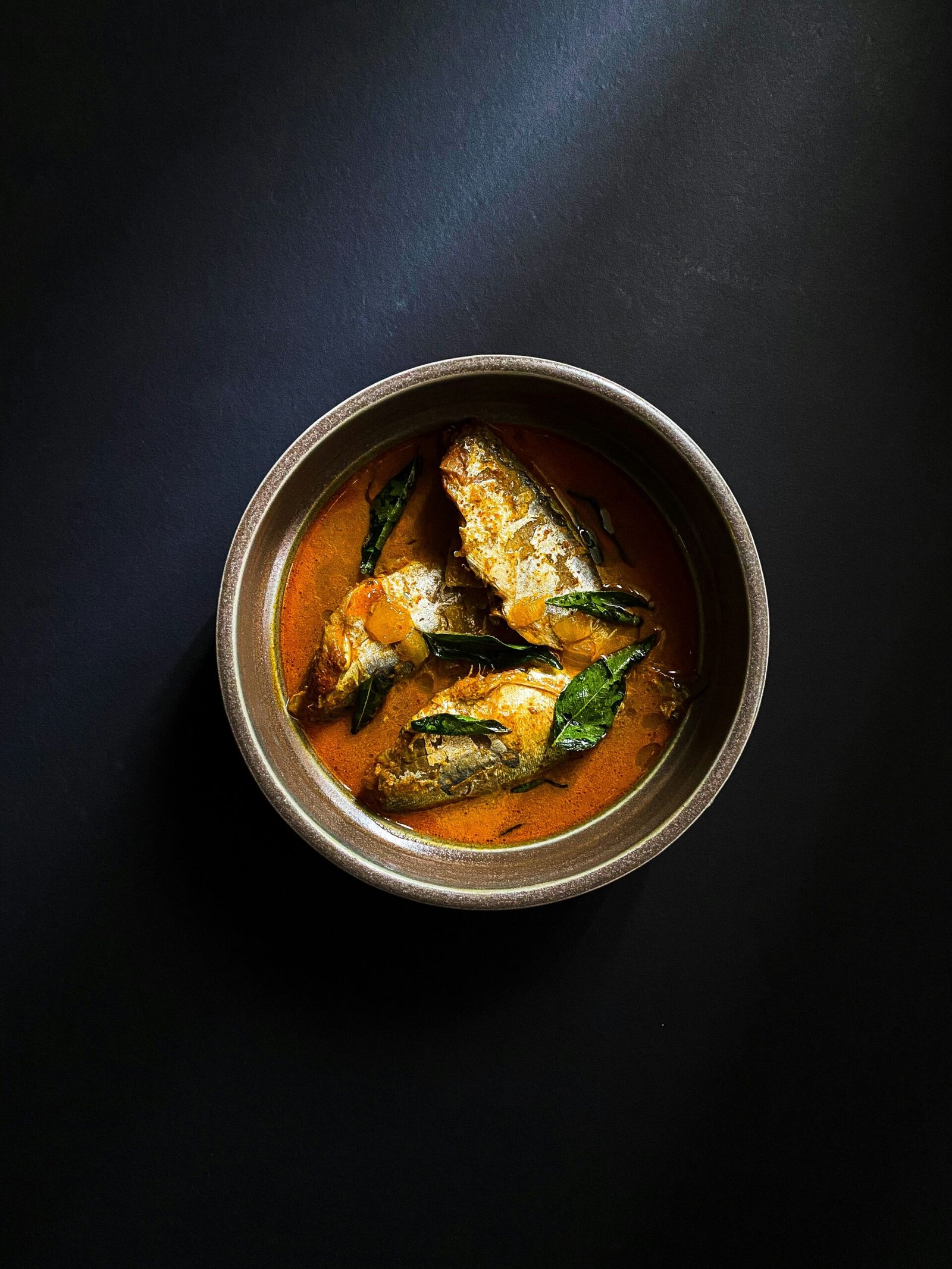Introduction to Fish Curry
Fish curry, a culinary staple in many coastal and riverine communities, embodies the rich tapestry of cultural flavors and traditions. Originating from regions where fishing is a primary livelihood, fish curry has evolved into a beloved dish across the globe, renowned for its myriad of variations and tantalizing taste. Each region has imbued its local fish curry with unique characteristics, making it an exquisite representation of regional cuisine.
South India is celebrated for its luxurious, coconut milk-based fish curries. These curries are creamy, aromatic, and often spiced with curry leaves, mustard seeds, and green chilies, creating a delicate balance of flavors. On the other hand, North India favors fish curries with a tangier profile, often infused with tomatoes, tamarind, and a robust blend of spices. These variations not only highlight the diversity within Indian cuisine but also attest to the nation’s rich culinary heritage.
The versatility of fish curry extends beyond India. In Southeast Asia, Thai fish curries incorporate ingredients like lemongrass, galangal, and kaffir lime leaves, resulting in dishes that are vibrant and zesty. Meanwhile, in the Caribbean, fish curry is infused with local spices, lending a fiery kick that aligns with the tropical climate. Each version reflects the local palate and available ingredients, proving that fish curry is a truly global phenomenon.
Beyond its delectable flavors, fish curry is also associated with numerous health benefits. Fish, as a primary ingredient, is a lean source of protein, rich in omega-3 fatty acids, essential for cardiovascular health and cognitive function. The spices used in curry, such as turmeric, cumin, and coriander, are known for their anti-inflammatory and antioxidant properties, enhancing the nutritional profile of the dish.
In essence, fish curry is more than just a meal; it is a flavorful journey through diverse cultures and culinary techniques, offering a harmonious blend of taste and health benefits. As we delve deeper into the art of cooking fish curry, we explore not only the recipes but also the stories and traditions that make it an enduring favorite.
Selecting the Right Fish
Choosing the appropriate type of fish is paramount in ensuring your fish curry is both flavorful and texturally pleasing. When selecting fish for curry, several factors such as flavor, texture, and oil content need to be considered. Fish like mackerel, salmon, and tilapia are often favored due to their specific qualities that complement the rich, aromatic spices used in curries.
Mackerel, for instance, offers a robust flavor and oily texture that melds well with the bold spices, enhancing the overall taste. Similarly, salmon’s considerable oil content and firm texture make it an excellent choice, providing a delightful mouthfeel and ensuring the fish remains tender. Tilapia, although milder in flavor, absorbs the curry spices effectively and maintains a firm structure throughout the cooking process. These types of fish not only tolerate the extended cooking required in curry preparation but also contribute significantly to the dish’s depth and complexity.
Equally important is purchasing fresh fish. Fresh fish should have clear, bright eyes, shiny scales, and a mild sea-like scent. The flesh should be firm to the touch, not mushy, and should bounce back when pressed. Always check for discoloration or off-putting smells as these are clear indicators of a fish’s lack of freshness. Frozen fish can be a viable option, especially when fresh options are limited. However, ensure that the frozen fish is properly thawed and drained before use to prevent a watery curry.
In today’s environmentally conscious world, sustainable fishing practices are more critical than ever. Opting for fish sourced from sustainable fisheries helps protect ocean ecosystems and ensures the longevity of fish populations. Look for certifications such as the Marine Stewardship Council (MSC) label, which indicates that the fish was harvested responsibly.
By prioritizing quality, freshness, and sustainability when choosing fish, you not only master the art of cooking fish curry but also contribute positively to the environment. This careful approach lays a solid foundation for a delicious and ethically responsible meal.
Preparing Ingredients and Cooking Techniques
Creating an impeccable fish curry necessitates the use of high-quality, fresh ingredients and a thorough understanding of essential cooking techniques. The foundation of a traditional fish curry lies in the fresh fish you select, alongside a medley of spices that typically include turmeric, cumin, and coriander. Coconut milk or tamarind, depending on regional variations, contribute to the curry’s distinct flavor profile, while vegetables such as tomatoes, onions, and green chilies enhance both taste and texture.
The preparation begins with cleaning the fish meticulously to ensure it is free from scales, bones, and entrails. Once cleaned, the fish can be marinated with a combination of turmeric, salt, and lemon juice. This not only infuses the fish with flavor but also helps to mitigate any lingering odorous notes. Concurrently, all other ingredients should be measured and prepared to streamline the cooking process.
Mighty as they are, spices are best when freshly ground. A curry paste is made by blending onions, garlic, ginger, and the ground spices emblematic of your preferred fish curry recipe. This paste forms the aromatic base that will anchor the dish. The curry paste is typically sautéed in a pan with oil until it reaches a fragrant, golden-brown hue, signaling it is time to layer in additional spices and liquids.
As for cooking techniques, sautéing stands paramount, followed by simmering and occasionally slow cooking. Sautéing the paste and spices until they release their oils and aromas significantly enhances the depth of flavor. The addition of coconut milk or tamarind broth must be timed carefully, avoiding abrupt temperature changes that could curdle the curry. Simmering the fish gently ensures it absorbs the complex flavors while remaining tender and succulent. Overcooking should be scrupulously avoided to preserve the delicate texture of the fish. An optional slow-cooking phase provides additional time for the melded flavors to reach their fullest expression, yielding a harmoniously balanced curry.
Serving and Pairing Suggestions
Fish curry is a versatile dish that can be served in several delectable ways. One of the traditional accompaniments for fish curry is rice. Steamed basmati rice or a fragrant jasmine rice provides a perfect bed to soak up the rich and aromatic curry. Additionally, Indian breads such as naan or roti can be excellent choices, offering a delightful way to scoop and savor the curry, enhancing the overall dining experience.
For those interested in infusing a contemporary touch, fish curry can also serve as a star ingredient in fusion dishes. Consider incorporating it into tacos, where the richly spiced fish can be balanced with crisp slaw and a drizzle of lime-infused cream. Alternatively, fish curry can be used as a topping for noodles or even incorporated into a risotto, adding a spicy kick to these otherwise mild dishes.
Side dishes play a crucial role in complementing the robust flavors of fish curry. A simple vegetable stir-fry with ingredients like green beans, bell peppers, or broccoli can add a fresh, crunch dynamic that pairs well with the soft texture of the fish. Pickles, such as lemon or mango pickles, provide a tangy counterpoint that enhances the depth of the curry. Salads with fresh greens, cucumbers, tomatoes, and a light vinaigrette can add a refreshing pause between bites of rich curry.
When it comes to beverage pairings, a crisp white wine like Sauvignon Blanc or a light beer can complement the spices without overwhelming the palate. For a non-alcoholic option, traditional Indian beverages such as sweet or salted lassi present a soothing balance to the heat of the curry. Coconut water, with its natural sweetness and refreshing properties, is another excellent choice that harmonizes well with spicy dishes.
Finally, garnishing ideas can elevate the presentation and flavor profile of fish curry. Fresh cilantro leaves, thinly sliced green chilies, or a squeeze of lime can add vibrant color and an extra layer of flavor. Toasted coconut flakes or a sprinkle of freshly ground black pepper can provide a delightful finishing touch, making the dish as visually appealing as it is delicious.



